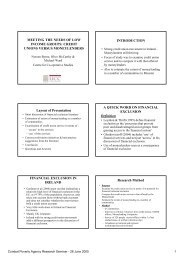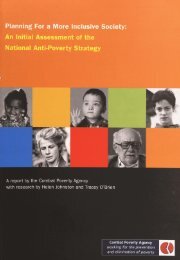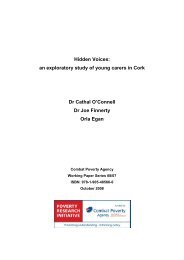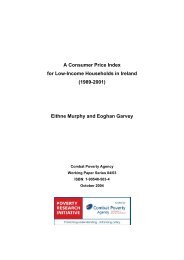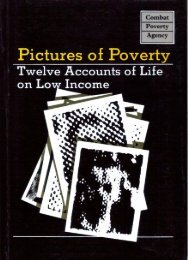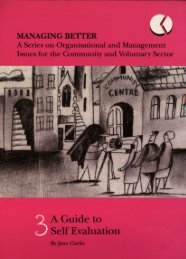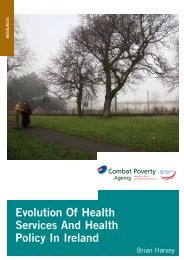The Distribution of Income in Ireland (2000) - Combat Poverty Agency
The Distribution of Income in Ireland (2000) - Combat Poverty Agency
The Distribution of Income in Ireland (2000) - Combat Poverty Agency
- No tags were found...
Create successful ePaper yourself
Turn your PDF publications into a flip-book with our unique Google optimized e-Paper software.
28 <strong>The</strong> <strong>Distribution</strong> <strong>of</strong> <strong>Income</strong> <strong>in</strong> <strong>Ireland</strong>Table 3.9: Position <strong>in</strong> the <strong>Income</strong> <strong>Distribution</strong> <strong>of</strong> PersonsCategorised by Sex <strong>of</strong> Household Head, 1994 and 1997 LIISurveysA: 1994B:1997Qu<strong>in</strong>tileBottom234TopAllBottom234TopAllPosition <strong>in</strong> Equivalised (1/0.66/0.33) Disposable<strong>Income</strong> <strong>Distribution</strong> (%)Male or Couple Head19.117.320.921.521.2100.017.419.220.621.221.5100.0Female Head24.335.614.911.813.4100.035.724.915.813.010.7100.0Figure 3.3 categorises people by the labour force status <strong>of</strong> thehead <strong>of</strong> their household, and we see that those <strong>in</strong> householdsheaded by an employee are mostly located <strong>in</strong> the top threequ<strong>in</strong>tiles. Those <strong>in</strong> households with a self-employed head arerelatively heavily concentrated both at the bottom and at thetop <strong>of</strong> the <strong>in</strong>come distribution. Those <strong>in</strong> households headed bya farmer are fairly evenly spread over the distribution. Over 60per cent <strong>of</strong> those <strong>in</strong> households headed by an unemployed personwere <strong>in</strong> the bottom qu<strong>in</strong>tile <strong>in</strong> 1994, and by 1997 this hadrisen to 68 per cent. Those <strong>in</strong> households headed by a retiredperson were heavily concentrated <strong>in</strong> the second and thirdqu<strong>in</strong>tile from the bottom <strong>in</strong> 1994, but by 1997 the proportion <strong>in</strong>the bottom qu<strong>in</strong>tile had risen a good deal. Those <strong>in</strong> householdswhere the head works full-time <strong>in</strong> the home were mostly <strong>in</strong> thebottom 2 qu<strong>in</strong>tiles <strong>in</strong> each year.<strong>The</strong> <strong>Distribution</strong> <strong>of</strong> <strong>Income</strong> <strong>in</strong> the 1990s 29Figure 3.3: Position <strong>in</strong> the <strong>Income</strong> <strong>Distribution</strong> <strong>of</strong> PersonsCategorised by Labour Force Status <strong>of</strong> Household Head,1994 LII Survey*Employee Self- Farmer Unemployed Retired Home Dutiesemployed• Bottom D2 S3 B4 DTopEmployee Self- Farmer Unemployed Retired Home Dutiesemployed• Bottom D2 S3 B4 OTop* See Table A2.3 <strong>in</strong> Appendix 2 for data.F<strong>in</strong>ally, Table 3.10 focuses on a categorisation by the number <strong>of</strong>adults and children <strong>in</strong> the household. This shows that those <strong>in</strong> 1-adult households were heavily concentrated <strong>in</strong> the secondqu<strong>in</strong>tile from the bottom <strong>in</strong> 1994, and <strong>in</strong> the bottom qu<strong>in</strong>tile <strong>in</strong>1997. Those <strong>in</strong> households compris<strong>in</strong>g 1 adult with childrenwere very heavily concentrated right at the bottom <strong>of</strong> the distribution,though less so <strong>in</strong> 1997 than <strong>in</strong> 1994. A relatively highproportion <strong>of</strong> those <strong>in</strong> households compris<strong>in</strong>g couples with 1 or




